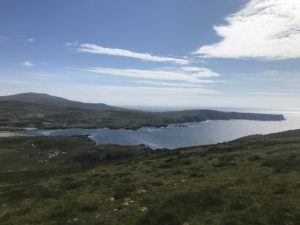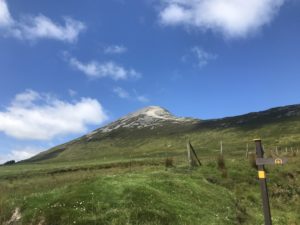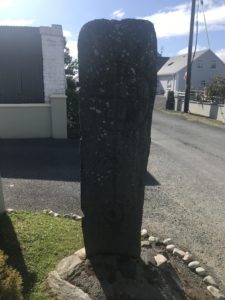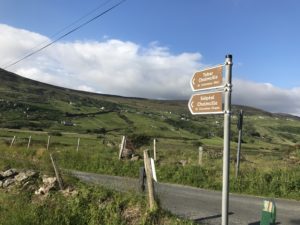While I was preparing to leave Ireland, I decided to give myself some time to decompress and process my experience before I sat down to write my final blog/reflection. I wanted the opportunity to readjust myself to my regular schedule, so I could hopefully see my trip in a new light. I feel it has been a good idea, as now I can see how much my abilities have improved and how much I learned in a more overall sense. The chance to live with a native speaker, engage with the language on a daily basis, and utilize the language in a more natural setting than the classroom has greatly benefitted me. I feel much more at ease talking in Irish, and on occasion, even find myself thinking in Irish. The value of studying a language by living where it is used on a day-to-day basis in indescribable. It seems to me the only way to truly understand and learn a language is to live it, as much as that is possible. By the end of my trip, I could speak with and understand native/proficient speakers at a much higher level than when I first arrived. Additionally, I do feel that I have learned many natural Irish phrases to use; it was great to not just attempt to directly translate my English thoughts into Irish, but to try and use more organic, natural Irish ones. While I am unsure of my ability to read and write as of now, since both my course and interactions were almost exclusively verbal, I was able to understand a lot of the signage throughout the Gaeltacht areas I was in. Because this was essentially my first extended trip outside the US, it was an eye-opening experience. This was my first look at how people from other countries view both the US and the world. I got an interesting perspective on both recent history and the current political situation here and abroad. But despite the many differences I noticed, there were similarities as well. Many of us at Oideas Gael had watched the tv show Derry Girls. Since we were all in Ireland to learn Irish, it is perhaps not extremely surprising, but it was cool to see that we all enjoyed the same show. An SLA experience is definitely worthwhile, and certainly beneficial for anyone learning a language. If you can go in with an open mind and willingness to try new things, the experience will not disappoint. I will enjoy continuing to improve my Irish throughout the next two years, and while I do not yet know what I will do post-graduation, I plan to keep up with my study of Irish. The skills and confidence I have acquired will benefit in many areas in the coming years, not least during my semester abroad in Rome this coming spring. There, I will be able to utilize my skills and prioritize my experiences as to maximize my language progression with Italian. Seeing the world through a different lens will not only be an academic benefit, but also a general one. It is always good to be informed and to learn as much as one can about a given situation, so I’m excited to continue expanding my worldview.
Author: David Berg
Slán Abhaile
My time at Oideas Gael has officially come to a close. While I’ll be happy to return home and see family and friends, I know that a part of me will always miss this summer and the friends that I made and the opportunities I had. My Irish has improved greatly, although not as much as my comfort and willingness to use it has. After leaving Oideas Gael, I made a quick side trip to Westport, County Mayo. I actually got the chance to have a full 5-minute conversation about music in Irish with one musician in the pub yesterday afternoon. It provided an amazing chance to combine some of my previous vocab and grammar from classes at Notre Dame with the extra vocab, pronunciation, and other speaking skills I acquired this summer. It was quite a fun experience for both me and the musician, who was shocked to find an American boy speaking to him in Irish. Later that night, I had the chance to sing a song during a music session in the same pub. I chose “Óró, sé do bheatha ‘bhaile” because it is a song we sang my first week at Oideas Gael. It was so cool to take part in this traditional Irish activity, and it was even more fun to be able to in the Irish language. I know that before this summer, I never would have attempted to sing in front of a group of people in English, never mind in Irish. On a different note, I learned something fascinating my last week. We were discussing the fact that all the names of languages are feminine in Irish except English, which is called Bearla. I had always wondered why but never thought to ask anyone, figuring it was just a weird, random thing. As it turns out, there is a good historical reason for it. The people from England speaking some predecessor of English would have been the first foreigners the Irish came into contact, so they called the language Bearla because that word (or some similar form) essentially meant jibberish in Old Irish. They were not, in this case, naming the language after the people speaking it, but simply what it sounded like! I loved learning this, and it perfectly sums up how I felt about my experience as a whole—I learned much more than just vocab or grammar, but also history, culture, and so much more. I hope that one day in the future I’ll have the opportunity to return to Oideas Gael and continue to improve my knowledge of not only the Irish language, but the rich culture and history that are intricately interwoven with the language.
A view of from Glen Head, the mountain overlooking Gleann Cholm Cille from the North. The mountain also appears on the crest of the local GAA club, Naomh Columba.

Croagh Patrick, the holy mountain near Westport, County Mayo. It is on this mountain that St. Patrick is said to have banished the serpents from Ireland.
Ag Leamh na Comharthaí
As I approach the end of my time here in Ireland, I am both shocked and thrilled by how far I have progressed. I have become much more proficient speaking and listening, especially to the Ulster dialect. Perhaps even more importantly, my confidence in my own abilities has skyrocketed. I have felt much more comfortable slipping into Irish while talking with someone, a skill I tried at the pub a few nights ago. As I explained that I was majoring in Irish and taking a course at Oideas Gael, the man asked if I spoke any. I responded simply in Irish, stating “Tá Gaeilge agam; níl sé an-mhaith, ach tá Gaeilge agam” (I have Irish; it isn’t very good, but I have Irish). He was shocked. He then complimented me, laughingly saying that I had more than him but he’d moved back from Switzerland to learn and to make sure his kids learned it while they were young. It was fun to use my Irish with someone new, and to feel confident enough to initiate the interaction in Irish. I have also been taking advantage of the bilingual signage throughout the area. It provides a fantastic opportunity to practice reading and translating, something we haven’t focused on very much in classes. Both An Trá Ban (the Silver Strand) and Sliabh League have great signs that are both interesting to read and fun to try and understand as Gaeilge. It’s been fascinating to see the historical and cultural aspects of the area, and I hope to keep exploring and better my Irish at the same time!


An Trá Ban, a beach about 10km from Oideas Gael, considered one of the most beautiful beaches in Ireland, and Sliabh League, a mountain with the highest sea cliffs in Europe.
Comhrá agus An Tuaisceart
The days have been flying by in Gleann Cholm Cille. The six days of class a week have been very tiring, leaving little time for outside activities. I have gotten to be with a couple different teachers now, including one with the Munster dialect. My speaking abilities have certainly been getting better, as I was able to understand and hold a full conversation with a native speaker from just up the road in Donegal. While the accent and pronunciation differences proved tough, my previous exposure to the dialect in past weeks helped immensely, as did his willingness to slow his speech and repeat himself if I did not understand. It was a great feeling to be able to understand and respond in a natural conversation and not just one in class. After classes, we always have a nightly program, which varies ever day but essentially repeats every week. We did, however, get the chance to listen to an Irish harp concert the other night. This rare event provided an interesting point of view on my time here in Donegal. The harpist, Janet Harbison, is widely known throughout the traditional music world and has been coming to Gleann Cholm Cille since the 1980’s. She told a number of stories throughout the night, including one of her and the Belfast Harp Orchestra winning a 1993 Grammy for a collaboration with The Chieftains. The really intriguing part of the story was that the orchestra, a youth one, included both Catholics and Protestants. Her attempt to bring people together during the Troubles demonstrated an attitude many people, especially from the north, expressed when the topic arose. Because Brexit has become such a looming issue, the possibility of violence breaking out again has risen substantially. However, everyone I talked to from the north about the issue favored finding a road to peace rather than a staunch, more antagonistic approach. One friend of mine, a man from Tyrone, remarked that while he would like a united Ireland, he did not want it at the cost of more violence. He admitted that cultural differences could prove hard to overcome. Hopefully, this attitude will prevail as the seeming inevitability of Brexit approaches.
Turas Cholmcille
Dia daoibh! I’ve had a bit of a late start getting to the blog writing, but it’s been very busy so far. For such a small rural area, Gleann Cholm Cille has had quite a few things going on. With classes during the day six days a week and other various activities in the evenings, down time has been relatively hard to come by. The weather so far has been gorgeous, which I’m told is unusual, so I’ll count myself lucky so far and hope that the nice weather holds out the rest of the trip! While the Donegal accent originally sounded almost undecipherable, it’s slowly starting to make more sense and I have been able to understand it reasonably well. It wasn’t until my second or third day here that I realized the name Gleann Cholm Cille (in English, the Glen of Saint Colmcille) referred to the general area, and not the actual village where Oideas Gael is located and I am staying. My first week in town happened to coincide with the feast of Saint Columba, known in Irish as Naomh Colm Cille. While the name Colmcille means nothing in English, the Irish version of the name translates to “Dove of the Church”. It stands as a great example of the importance of the Irish language in un derstanding the local culture and place names. There were a number of people who undertook the local annual pilgrimage, and while I did not make it on the pilgrimage, I was lucky enough to get to walk a portion of the tour with a group from Oideas Gael led by a local man teaching at Oideas Gael. While visiting a ruin known as the Chapel of Saint Colmcille we learned a few legends about him and the supposed folk remedies associated with the chapel and the holy well nearby. While there’s no historical evidence that Saint Columba ever visited this area of Donegal, the folk traditions of the area certainly believe he did. We also passed a number of carved standing stones, traditionally believed to have been created by early Christians, though now many experts hold that they were actually pre-Christian monuments incorporated into the Christian tradition early on. Hopefully, as the summer wears on, I will have more opportunities to witness other aspects of folk beliefs and traditions. But, for now, feicfidh mé tú!

One of the standing stones, located on the edge of town just at the side of the road.

Sign post directing visitors towards the stone ruins of the Chapel of St. Colmcille and the Well of St. Colmcille, both located on the property of a local farming family.